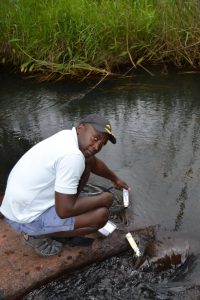Ms Lauren Zielinski specializes in the monitoring and evaluation of river systems, focusing  on river restoration and environmental flow projects. She holds a Bachelor of Science in Earth and Environmental Engineering with a concentration in Water Resources and Climate Risk from Columbia University in the United States of America, as well as an Erasmus Mundus Master of Science in Ecohydrology from the University of Lodz in Poland, the Federal University of Espirito Santo in Brazil, and UNESCO-IHE Institute for Water Education in the Netherlands. Ms Zielinski spent two years leading an ecosystem monitoring team as an AmeriCorps volunteer, focusing on river and wetland restoration projects in the Lake Tahoe Basin in California. She also has experience working on resource management plans for federal agencies in the United States of America. She currently owns her own company specializing in ecosystem monitoring and evaluation and has experience working on projects in the United States of America, Russia, Mongolia, Kenya, and Tanzania.
on river restoration and environmental flow projects. She holds a Bachelor of Science in Earth and Environmental Engineering with a concentration in Water Resources and Climate Risk from Columbia University in the United States of America, as well as an Erasmus Mundus Master of Science in Ecohydrology from the University of Lodz in Poland, the Federal University of Espirito Santo in Brazil, and UNESCO-IHE Institute for Water Education in the Netherlands. Ms Zielinski spent two years leading an ecosystem monitoring team as an AmeriCorps volunteer, focusing on river and wetland restoration projects in the Lake Tahoe Basin in California. She also has experience working on resource management plans for federal agencies in the United States of America. She currently owns her own company specializing in ecosystem monitoring and evaluation and has experience working on projects in the United States of America, Russia, Mongolia, Kenya, and Tanzania.
Project: Creating a Monitoring and Adaptive Management Framework for Environmental Flows
East Africa is a water-scarce area with a rapidly increasing population. Determination of environmental flows is needed to ensure that the basic human needs and ecological integrity of freshwater systems are maintained. In 2015 and 2016, environmental flow recommendations were created for the Kenyan portion of the Mara River Basin. In order to facilitate implementation of these recommendations, a monitoring and adaptive management plan needed to be created, something that had never been done in the East Africa region. For my MSc thesis, I was selected to lead the effort for developing this plan and supporting its implementation. I researched existing structures from around the world and created an integrated way to monitor and manage environmental flows. This plan was developed in close coordination with the local office of the Water Resources Management Authority and included three distinct components: an objectives hierarchy, a multi-level monitoring plan, and adaptive management cycles. Using my experience from the Mara River, I then generalized the process into a framework that could be used to create such plans in other river basins in Kenya, with the potential to be utilized in other river basins in the region and around the world


 lead, where his role focusses on representing WWF Internationally at global policy fora and assisting WWF freshwater basin teams with influencing water policy and governance in their respective countries. He previously worked for WWF South Africa, where he lead a programme around the protection of South Africa’s water source areas, involving a collective effort in bringing together corporates, government and civil society to achieve a water secure South Africa. The programme in itself is a flagship for the freshwater team in South Africa and through his work, water source areas have achieved national recognition, with Ministers and Members of Parliament all seeing the importance of conserving these areas and publicly acknowledging the value of partnering with WWF.
lead, where his role focusses on representing WWF Internationally at global policy fora and assisting WWF freshwater basin teams with influencing water policy and governance in their respective countries. He previously worked for WWF South Africa, where he lead a programme around the protection of South Africa’s water source areas, involving a collective effort in bringing together corporates, government and civil society to achieve a water secure South Africa. The programme in itself is a flagship for the freshwater team in South Africa and through his work, water source areas have achieved national recognition, with Ministers and Members of Parliament all seeing the importance of conserving these areas and publicly acknowledging the value of partnering with WWF. studied his BSc and MSc in aquatic ecology at the University of Zimbabwe before moving to Rhodes University in 2012 for his PhD studies. His PhD thesis on “Spatio-temporal variation in the phytobenthos and phytoplankton community structure along a river-estuary continuum” has added to the body of work new insights into our understanding of how substrate type, flood occurrence and allochthonous input contribute to phytoplankton community dynamics in temperate freshwater and estuarine systems. He was made a Research Associate with the South African Institute for Aquatic Biodiversity due to his exceptional professional involvement and contributions to South Africa aquatic ecology research which encompasses co-supervising and mentoring MSc and PhD students and collaborating in research projects.
studied his BSc and MSc in aquatic ecology at the University of Zimbabwe before moving to Rhodes University in 2012 for his PhD studies. His PhD thesis on “Spatio-temporal variation in the phytobenthos and phytoplankton community structure along a river-estuary continuum” has added to the body of work new insights into our understanding of how substrate type, flood occurrence and allochthonous input contribute to phytoplankton community dynamics in temperate freshwater and estuarine systems. He was made a Research Associate with the South African Institute for Aquatic Biodiversity due to his exceptional professional involvement and contributions to South Africa aquatic ecology research which encompasses co-supervising and mentoring MSc and PhD students and collaborating in research projects. on river restoration and environmental flow projects. She holds a Bachelor of Science in Earth and Environmental Engineering with a concentration in Water Resources and Climate Risk from Columbia University in the United States of America, as well as an Erasmus Mundus Master of Science in Ecohydrology from the University of Lodz in Poland, the Federal University of Espirito Santo in Brazil, and UNESCO-IHE Institute for Water Education in the Netherlands. Ms Zielinski spent two years leading an ecosystem monitoring team as an AmeriCorps volunteer, focusing on river and wetland restoration projects in the Lake Tahoe Basin in California. She also has experience working on resource management plans for federal agencies in the United States of America. She currently owns her own company specializing in ecosystem monitoring and evaluation and has experience working on projects in the United States of America, Russia, Mongolia, Kenya, and Tanzania.
on river restoration and environmental flow projects. She holds a Bachelor of Science in Earth and Environmental Engineering with a concentration in Water Resources and Climate Risk from Columbia University in the United States of America, as well as an Erasmus Mundus Master of Science in Ecohydrology from the University of Lodz in Poland, the Federal University of Espirito Santo in Brazil, and UNESCO-IHE Institute for Water Education in the Netherlands. Ms Zielinski spent two years leading an ecosystem monitoring team as an AmeriCorps volunteer, focusing on river and wetland restoration projects in the Lake Tahoe Basin in California. She also has experience working on resource management plans for federal agencies in the United States of America. She currently owns her own company specializing in ecosystem monitoring and evaluation and has experience working on projects in the United States of America, Russia, Mongolia, Kenya, and Tanzania.